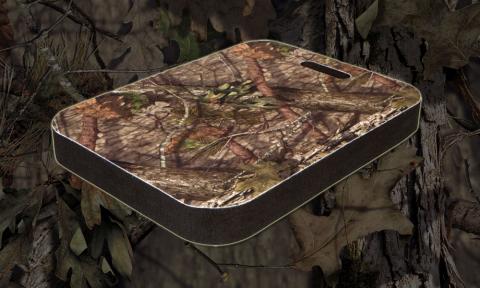The MSU Deer Lab
Bronson Strickland And Steve Demarais | Originally published in GameKeepers: Farming for Wildlife Magazine. To subscribe, click here.
One of the most common deer management prescriptions that biologists make are doe harvest recommendations. Doe harvest is critical to keep the deer density at a level the habitat can sustain and produce quality animals. If you are a gamekeeper, you know that deer herd control along with habitat management are critical if you are interested in producing quality bucks. Often, some collateral damage associated with doe harvest is the accidental harvest of buck fawns, or “button bucks.” In this article, we’re going to review the basic biology of “button bucks” and provide some suggestions for how to minimize accidents.

What is a button buck? Many folks often call a button buck a yearling, but it is actually a fawn. The button buck is born in late spring, summer, or early fall, depending on your location. Come hunting season, the button buck will be four to eight months old. A yearling, on the other hand, is a deer experiencing its second year of life and will be 12 to 24 months old. Some hunters claim that if a deer has lost its spots, it’s no longer a fawn, but that is not true. Regardless of the spots, if a deer is experiencing its first hunting season, it’s a fawn.
So what are the “buttons?” Buttons are actually the very first effort the buck fawn makes to produce antlers - like building a home; he starts by laying down a foundation. His foundation is called a “pedicle,” which is an outgrowth from his skull, and is the base from which future antlers will grow. He starts developing his pedicle at about four months of age, depending upon nutrition. By four months of age, a careful hunter using their scope or binoculars will notice these pedicles. They enlarge as he ages and as the season progresses may reach one inch in length. These buttons are the key to distinguishing a button buck from a doe fawn.
Although antlers get all the attention, the pedicle is a very important structure and if grown under poor nutrition it will stunt antler size for years to come. Additionally, if damaged, a pedicle can permanently impair antler growth. We see this quite often in older bucks that damage a pedicle while fighting. When this happens, the antler that grows from the damaged pedicle will typically be smaller and disfigured. Many folks believe this is a genetic problem, but it’s simply pedicle damage.
After the pedicle is formed the next step for a buck fawn is generating some antler. Depending on when the fawn was born and his level of nutrition, about 30 percent of six to eight- month old button bucks actually grow more than a pedicle their first winter and rub off the velvet to reveal a hardened antler about ¼ to ¾ of an inch in length. This hardened antler usually isn't visible until late or after hunting season so many hunters never see it. Some buck fawns are born late in the year and never have a chance to produce any visible antler, but you can feel their head and notice the bumps, or pedicles, beneath the skin. Other bucks that were born earlier will have time to actually produce antler that breaks the skin. This small, rounded antler is the “button.”
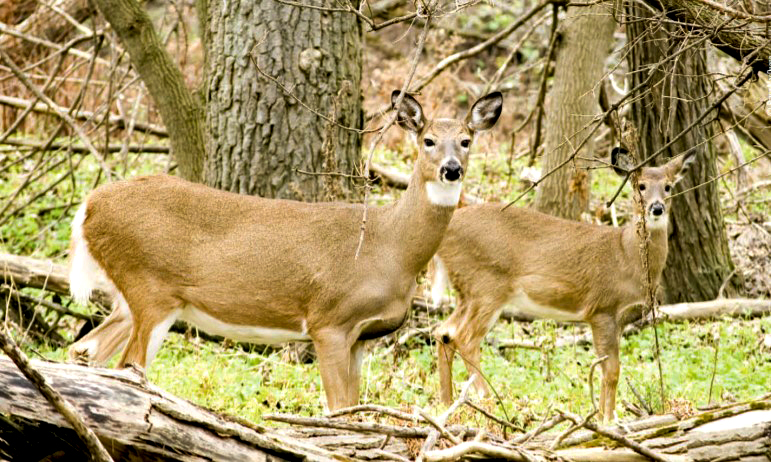
Overall, the sex ratio of fawns is close to even. As with most mammals, there are typically a few more males born than females (usually a ratio of around 55 percent male and 45 percent female). Deer biologists assume this is Mother Nature’s way of accounting for the increase in the mortality rate of males. It’s the curse of testosterone – males die more often than females. So keep in mind, every time you pull the trigger or release the string on a fawn, there’s about a 50-50 chance you'll put down a buck.
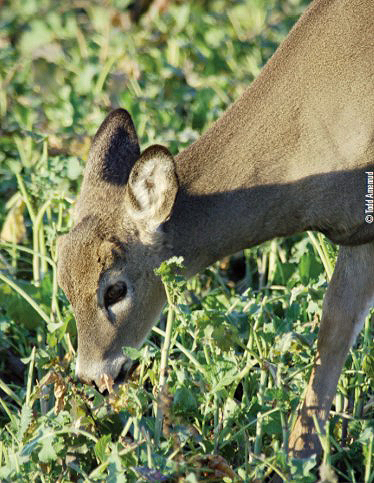
four months old, depending upon nutrition. Quality
forage is extremely important for a first-year fawn, both
bucks and does. The availability of quality nutrition
early on can affect antler growth the rest of their life.
So we’ve learned what a button buck is, but how do you keep from making accidental harvest mistakes? Hunters have many strategies and opinions regarding when doe harvest should take place. Some prefer to wait until the end of the season because they want as many does as possible on their property during the rut. We think this is a theoretically viable strategy, but just not practical because hunters or hunting clubs that invoke this strategy usually don’t get the prescribed number of does harvested. They are too busy buck hunting during the rut and post rut, and when they decide to take an antlerless deer they make more button buck mistakes at the end of the season.
We prefer, and advise, hunting clubs to harvest their does early for very practical reasons. First, fawns are much easier to identify during bow season or early in gun season. As the hunting season progresses, those little fawns look more and more like adult does. This is most evident if you conduct a postseason camera survey to get accurate population numbers and a good estimate of fawn recruitment. More times than we can count we have struggled to determine if the deer in a trail cam photo is a fawn or adult doe. So the longer you wait, the harder it will be to tell the difference.
Along with decreasing the odds of making a harvest mistake, you will increase the odds of getting your quota of does harvested. Waiting until the last minute, or in this case, waiting until the last week of deer season, will usually result in insufficient doe harvest. Remember, does sense hunting pressure too and become increasingly difficult to harvest as the season progresses.
Lastly, harvesting your does earlier in the season yields more reliable lactation data. Lactation data provide a critical index to biologists regarding the productivity of your deer herd and if your management activities are working. Lactation data can also be a good indicator of predator impacts. The lactation index is simply the percentage of adult (2.5 and older) does that were lactating at the time of harvest. High lactation numbers tell a biologist that many fawns are being successfully reared. On the other hand, low lactation numbers can mean the food supply is limited and/or you have a predator problem. If does are harvested late in the deer season the lactation index becomes less accurate because does will naturally start drying up and you can no longer determine if she successfully raised a fawn. Just another good reason to harvest does early.
So what are some tips to help you identify button bucks? The first advice we give is never harvest an antlerless deer that is alone. That is, always pick the adult doe from a group of antlerless deer as this will minimize errors. When you have an adult doe and a couple of fawns it will typically be easier to identify the adult because of the size difference. The simple rule of never harvesting an antlerless deer alone will likely reduce about 90% of button buck mistakes.
If one deer is not clearly larger than the others, then examine the shape of their heads. The next time you see an adult doe with fawns take some time to compare head shape. The adult doe’s head will appear much longer while the fawn’s head will appear more compact. We use the image of a triangle to help hunters see the difference. When viewing an adult doe’s head from the side, or profile view, it will appear like an elongated, isosceles triangle (2 sides are equal and longer), whereas the fawn’s head will be more compact and appear more like an equilateral triangle (all sides are closer to equal length).
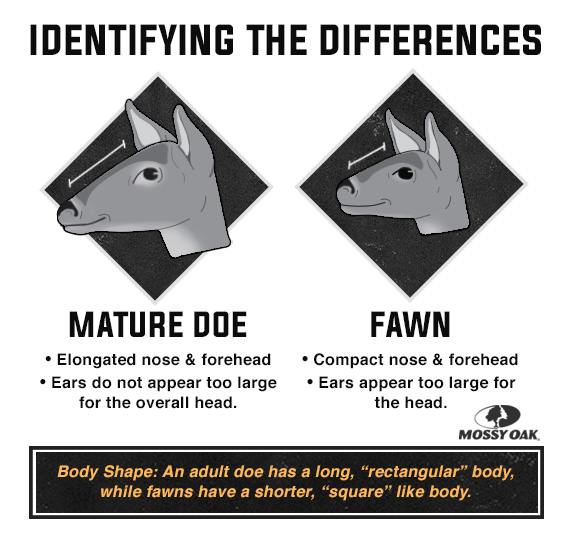
The next distinguishing feature of buck and doe fawns is the shape of the top of their head, between their ears. When looking straight on (preferably with binoculars), the top of the buck fawn’s head will appear more flat, whereas the top of the doe fawn’s head will appear more rounded.
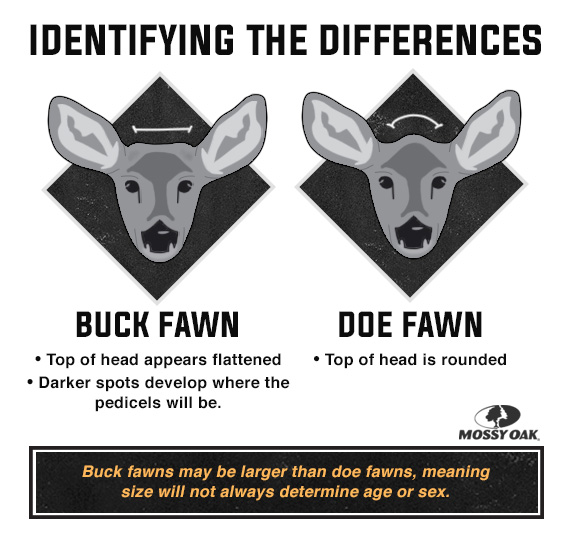
The difference in the shape of the top of their heads (between their ears) is the presence or lack of pedicles. Even if antlers have not broken the skin the presence of pedicles beneath the skin make the top of the head appear more flat.
The last advice we have to avoid harvesting a button buck by mistake is based on behavior. This is most evident during the rut when mother is being courted by an adult buck and the fawns are left to fend for themselves for a day or two. This can be a time when a button buck is vulnerable and the first rule about never harvesting an antlerless deer alone can break down. If the mother is indeed being courted by an adult buck during the rut and the two fawns (one buck fawn and one doe fawn) step out into an opening or food plot, which deer will appear largest? That’s right, the button buck. Often a hunter can misinterpret this situation. To the hunter the button buck appears to be an adult deer with a smaller deer (the doe fawn) at its heel. This is where the hunter has to use caution and use the second rule – pay close attention to the shape of their heads.

under good nutrition they can have a positive influence on
antler size for the rest of the buck's life.
We tend to be very conservative when making a harvest Whether it’s harvesting antlerless deer, or being unsure if a buck in the crosshairs is mature or not, we choose to be conservative to decrease the odds of making a mistake. However, even with all the practice and patience, eventually, everyone makes mistakes. Most every group of hunters that has a goal of harvesting 20-100 does on their property each year will make mistakes, and often this can cause much turmoil among the hunting group. But please don’t throw the baby out with the bathwater – mistakes will happen, it’s not the end of the world. This is especially true for youth hunters, we need to encourage and educate them, not make them feel badly for harvesting a buck fawn. Keep in mind what is the greater good. For the health and quality of the deer population, it’s much better to reach your doe harvest goals each year with a few mistakes than to chronically fall short of the doe harvest goals because some hunters will get so upset if a few buck fawns were accidentally harvested.
The last point to consider is yearling buck dispersal. Research has shown that about 70% of the yearling bucks will disperse from your property. Dispersal is the process of an animal moving from the area it was born to the area it establishes its adult home range. Most animal species exhibit some form of dispersal to ensure that a population has an exchange of individuals, and genetics, over time. The terms immigration and emigration are defined relative to your perspective. Animals that disperse onto your property are considered immigrants and animals that disperse from your property are considered emigrants. This means that most of the adult bucks that reside on your property were not born on your property. Conversely, most of the bucks born on your property reside on your neighbors’ properties as adults.
Good deer management involves the use of selective harvest that targets does and lower-quality adult bucks (selective buck harvest is another story for another day) to keep the deer population within the habitat’s carrying capacity. Another pillar of good deer management is allowing younger bucks with the greatest potential for antler development to grow to maturity. So while harvesting younger bucks is rarely recommended, the occasional inadvertent harvest of button bucks is going to happen from time to time. Keep in mind the greater good and don’t lose focus of your most important management objectives. Mistakes happen, but it’s not the end of the world.

















